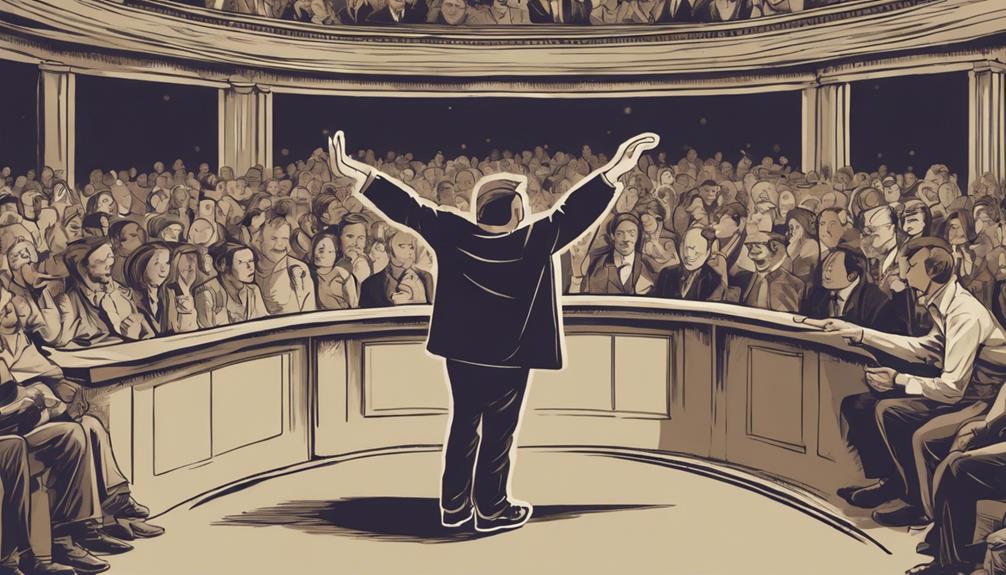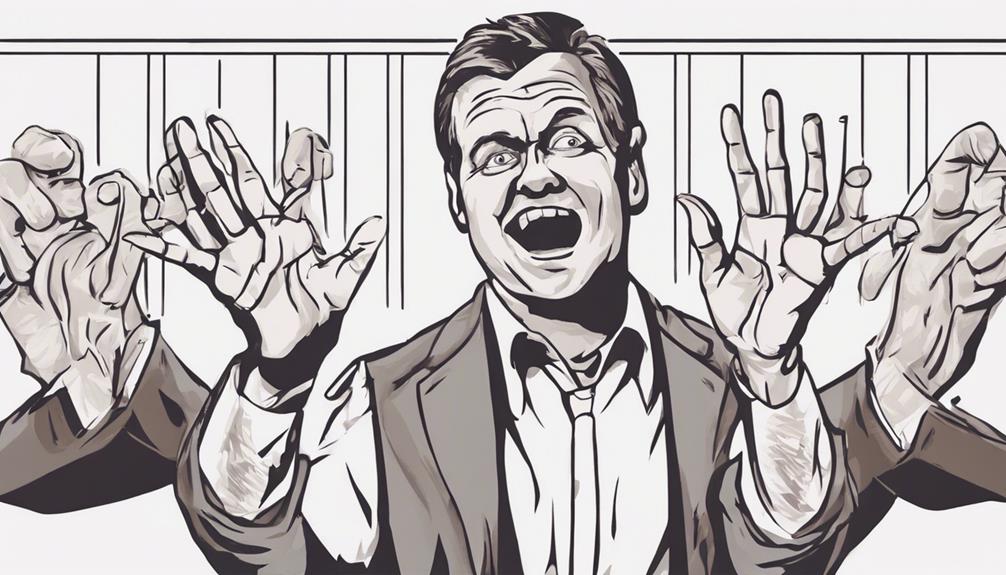Unveiling the art of stage hypnosis involves mastering powerful techniques like suggestion, rapport-building, and creating captivating illusions. By strategically using language, non-verbal cues, and eye fixation, hypnotists mesmerize audiences and blur the lines between reality and imagination. Establishing trust through rapport and eliciting subconscious responses are key elements for successful hypnosis performances. Delve into the world of stage hypnosis to uncover the secrets behind captivating shows that leave a lasting impact on both participants and spectators.
The Power of Suggestion

Utilizing the profound influence of suggestion lies at the core of effective stage hypnosis performances, where skilled practitioners harness the power of the mind to entertain and captivate audiences.
Through subconscious influence and mental manipulation, stage hypnotists are able to tap into the depths of the human psyche, guiding individuals into a state of heightened suggestibility. This state allows for hypnotic persuasion to take place, where suggestive techniques are used to create illusions, trigger responses, and elicit entertaining behaviors from volunteers.
Hypnotic persuasion involves the strategic use of language patterns, tone of voice, and non-verbal cues to subtly influence the subconscious mind of participants. By carefully crafting their suggestions, stage hypnotists can lead individuals to believe and act upon scenarios that may seem out of the ordinary in a waking state.
This skillful manipulation of the mind forms the foundation of a captivating stage hypnosis performance, where the boundaries between reality and imagination blur, leaving audiences in awe of the power of suggestion.
2. Establishing Rapport
Establishing rapport with volunteers is a key element in creating a successful stage hypnosis experience, as it sets the foundation for a deep connection and trust essential for inducing hypnotic states. Building trust is crucial in gaining the cooperation of participants and allowing them to feel comfortable enough to let go and follow suggestions.
One effective way to build rapport is through mirroring body language. By subtly matching the volunteer's posture, gestures, and facial expressions, a hypnotist can establish a subconscious connection that fosters a sense of familiarity and unity between them. This mirroring technique can help volunteers feel more at ease and open to the hypnotist's instructions, creating a conducive environment for the hypnotic experience to unfold smoothly.
In the world of stage hypnosis, establishing rapport is not just about the verbal communication between the hypnotist and the volunteers but also involves non-verbal cues that can significantly impact the success of the hypnosis performance. By focusing on building trust and mirroring body language, a hypnotist can lay a solid groundwork for a mesmerizing and engaging stage hypnosis show.
3. Utilizing Eye Fixation

One powerful technique employed in stage hypnosis involves directing the participants' focus through strategic eye fixation. By utilizing eye fixation, stage hypnotists can guide individuals into a state of deep trance, facilitating hypnotic induction and deepening techniques.
When participants fixate their gaze on a specific object or point, their attention becomes singularly focused, making them more receptive to suggestions and commands. This intense focus on the hypnotist's eyes or a mesmerizing object can enhance the depth of trance experienced by the subjects, increasing the effectiveness of the hypnosis session.
During a stage hypnosis performance, the hypnotist may use eye fixation to establish a connection with the participants, encouraging them to relax and enter a suggestible state. As individuals become more entranced through eye fixation, they are more likely to respond positively to the hypnotist's instructions, allowing for a captivating and engaging hypnosis experience.
Eye fixation serves as a powerful tool in stage hypnosis, enhancing trance depth and enabling hypnotists to orchestrate mesmerizing performances.
4. Triggering Responses
Triggering responses in stage hypnosis involves skillfully eliciting and manipulating subconscious reactions from participants through strategic cues and suggestions. Subconscious triggers play a vital role in guiding participants to respond in ways that appear involuntary but are actually influenced by the hypnotist's cues.
Utilizing subliminal messaging and hypnotic cues, a skilled hypnotist can create a scenario where audience participation becomes an integral part of the show. By planting subtle suggestions in the minds of participants, the hypnotist can trigger responses that align with the desired outcome of the performance.
During a stage hypnosis act, the hypnotist must carefully orchestrate the environment to facilitate these subconscious triggers. This may involve creating a relaxed atmosphere, using specific language patterns, and employing non-verbal cues to enhance suggestibility.
5. Creating Illusions

To enhance the mesmerizing effect of stage hypnosis, creating illusions is a key element that adds depth and intrigue to the performance. Hypnotic techniques play a vital role in crafting these illusions, allowing the hypnotist to captivate the audience and draw them into a world where reality blurs with suggestion.
Audience engagement is crucial in this process, as the success of the performance hinges on the participants' willingness to suspend disbelief and immerse themselves in the hypnotic experience.
Illusion creation is an art form that involves subtle manipulations, suggestion, and misdirection. By mastering the intricacies of illusion, a hypnotist can control the narrative of the performance and guide the participants through a series of captivating scenarios.
This not only showcases the hypnotist's skill but also enhances the overall dynamics of the performance, keeping the audience on the edge of their seats and leaving them in awe of the power of suggestion.
In the realm of stage hypnosis, creating illusions is a powerful tool that can elevate the show from mere entertainment to a truly unforgettable experience.
6. Handling Hecklers
Effectively managing hecklers during a stage hypnosis performance is a crucial skill that can maintain the flow and integrity of the show. Heckler management is a delicate art that requires finesse and quick thinking.
Audience interaction is key in handling distractions posed by hecklers. Engaging with the audience positively can help prevent heckling situations from arising in the first place.
However, if a heckler does appear, it's essential to address the situation promptly while maintaining control over the performance.
When faced with a heckler, it's crucial not to engage in a battle of wits or insults. Instead, respond calmly and assertively, redirecting the attention back to the show.
Acknowledge the heckler's comment with humor or grace, then smoothly transition back into the performance. By handling hecklers with composure, you can prevent disruptions to the hypnotic experience for both the participants and the audience.
7. Safe Dehypnotizing Practices

Implementing safe dehypnotizing practices is a critical aspect of ensuring the well-being and comfort of participants after a stage hypnosis performance. As a stage hypnotist, it is your responsibility to guide participants out of the hypnotic trance state in a safe and ethical manner.
Respecting ethical boundaries is paramount when dehypnotizing individuals, ensuring that their dignity and well-being are upheld throughout the process.
When bringing participants out of the hypnotic trance, it is essential to avoid abrupt awakenings to prevent disorientation or confusion. Using gentle and reassuring language can help ease the transition back to full consciousness.
Additionally, being mindful of any post-hypnotic suggestions that were given during the performance is crucial to ensure that participants do not experience any unintended effects after the show.
Prioritizing audience safety during the dehypnotizing process is key to a successful stage hypnotism performance. By following proper dehypnotizing protocols and techniques, you can help participants return to their normal state of awareness comfortably and securely.
Frequently Asked Questions
Can Anyone Be Hypnotized on Stage?
While the majority can experience a hypnotic state, ethical concerns arise when coercing individuals on stage. Success hinges on the performer's stage presence and charisma, aligning with audience expectations. Skilled hypnotists navigate these dynamics for engaging, ethical performances.
How Long Does a Typical Hypnosis Show Last?
A typical hypnosis show usually lasts between 60 to 90 minutes, with audience engagement maintained throughout by the hypnotist's adept show dynamics. Success in hypnosis is measured by the entertainer's ability to captivate and entertain.
What Kind of Preparation Is Needed Before a Show?
Prior to a hypnosis show, extensive preparation is essential. Mental relaxation techniques can help the hypnotist focus and connect with participants. Visualization exercises aid in crafting a successful performance by enhancing concentration and creativity.
Are There Any Risks Involved in Stage Hypnosis?
When considering stage hypnosis, it's essential to acknowledge potential dangers and prioritize audience safety. Risks may include psychological distress, physical harm, or the manipulation of vulnerable individuals. Proper training, consent, and ethical practices are crucial safeguards.
How Do You Choose Participants for a Hypnosis Show?
When selecting participants for a hypnosis show, it's crucial to engage the audience while identifying suitable candidates. Skilled hypnotists use subtle cues to assess suggestibility and choose willing volunteers, ensuring a captivating performance with strong stage presence.
Conclusion
In conclusion, mastering the art of stage hypnosis requires a deep understanding of the power of suggestion, establishing rapport with participants, utilizing eye fixation, triggering responses, creating illusions, and effectively handling hecklers.
By following safe dehypnotizing practices, performers can ensure a successful and entertaining show.
With practice and dedication, anyone can crack the code of stage hypnosis and captivate audiences with their mesmerizing skills.
